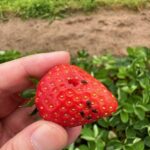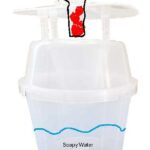As we head into the strawberry season, I anticipate more questions from growers when it comes to pests that directly damage the fruit. One that was reported recently was the Strawberry sap beetle. This beetle belongs to the family Nitidulidae, which are broadly referred to as sap or picnic beetles. The Strawberry sap beetle overwinters in perennial vegetation, mostly wooded areas. They move into the crop when ripe fruit becomes available. In general, this pest feeds on overripe or damaged fruit and therefore sanitation is the best strategy to manage this pest. It can be most difficult in you-pick operations where overripe fruit may be more common.
How do you recognize them?
Adults are going to be the first life stage present in the crop (Fig. 1). They are dusky brown in appearance, and about 1/8-1/4 inch long. They can be found feeding directly on the overripe or damaged fruit but often drop to the soil when disturbed. The adult females lay their eggs in the fruits themselves. Within 2-3 days the eggs hatch. Like all other beetles they go through complete metamorphosis, meaning egg-larvae-pupa-adult. The larval stage are small white ‘grubs’ with a brown head and can be up to 1/10 inch long, i.e. small and difficult to see. However, if you find a damaged fruit and open it up, they can be visible. We see another species commonly in sweetcorn ears where another insect (often corn earworm) has damaged the ear first.
What does their damage look like?
The most apparent and visible damage will be that caused by the adult beetle feeding and subsequent oviposition. The adults will create deep cavities or tunnels in overripe berries. Subsequent pathogen infections may occur because of this damage to the fruit.
How do you manage them?
As mentioned earlier, sanitation is the best strategy. Timely picking of ripe berries and removal of overripe and damaged fruit from the field will lessen the appeal of the crop to the beetles in the first place. Once they are present, there is a parasitic wasp that occurs naturally that helps to limit the population by reducing the number of eggs that are deposited by infected females. If it is hard for you to maintain timely picking and a clean field, such as in you-pick operations, you can mitigate the infestation by trapping beetles around the perimeter of the crop, intercepting them as they migrate from their overwintering locations. This would include placing ripe-overripe berries in trap buckets outside the field borders as the crop itself begins to ripen. The trap buckets can intercept migrants and reduce numbers in the ripening crop. Discard the trap contents frequently (3-4 days) and refill with new bait. You can create your own trap or use a bucket trap from a commercial supplier (Fig. 2). The use of insecticides to manage this pest can be difficult because they occur during the harvest period, therefore strict adherence to the Restricted Entry Interval (REI) and Pre-harvest Interval (PHI) are important and can be challenging. According to the Midwest Fruit Production Guide novaluron and bifenthrin offer excellent control with an REI of 12 hrs and PHI of 0d or 1d respectively. Always follow the label on the product; the label is the law.
- Figure 1: Strawberry sap beetle adults. Photo by Wenjing Guan.
- Figure 2: Mock design of a sap beetle bucket trap.

